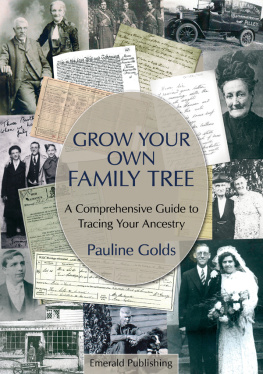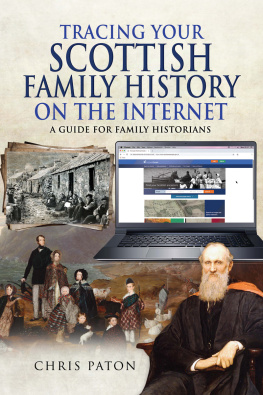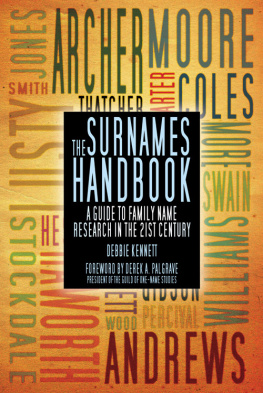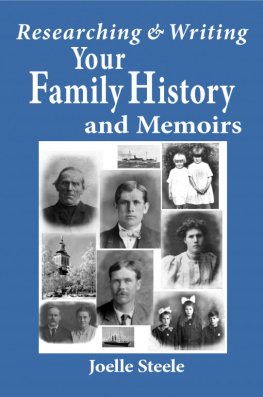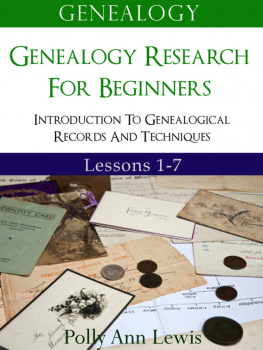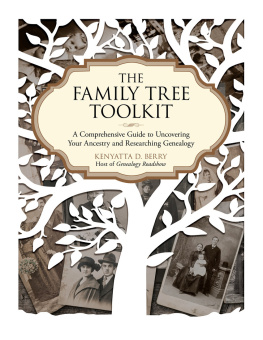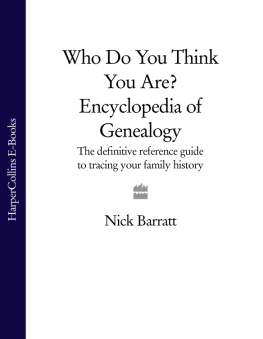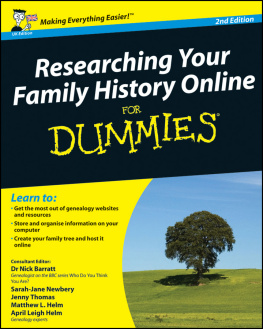GROW YOUR OWN
FAMILY TREE
A Comprehensive Guide
To
Tracing Your Ancestry
Pauline Golds
Emerald Publishing
www.emeraldpublishing.co.uk
Emerald Guides
Pauline Golds 2016-First Edition
All rights reserved. No part of this publication may be reproduced in a retrieval system or transmitted by any means, electronic or mechanical, photocopying or otherwise, without the prior permission of the copyright holders.
eISBN 978-1-84716-659-3
Kindle ISBN 978-1-84716-658-6
Printed by 4edge www.4edge.co.uk
Cover design by Pauline Golds/Bookworks Islington
Original images by Mikey Jackson www.mikeyjackson.com
Whilst every effort has been made to ensure that the information contained within this book is correct at the time of going to press, the author and publisher can take no responsibility for the errors or omissions contained within.
This Book is Dedicated to my Family
Those who have long since passed into the Silent Land, those who have travelled beside me along the way and those who are yet to begin the journey.
C ontents
Preface
About ten years ago when I found myself hurtling toward the grand old age of fifty, I began, for the first time, to feel mortal. It was about this time that the BBC series Who Do You Think You Are? was first aired and one of the first celebrities to participate was the actress Amanda Redman, who had been in my class at school. This got me thinking about my own ancestors. I realised that I didnt even know the Christian names of my grandparents or my grandmothers maiden names! Fortunately for me, the wonderful World Wide Web had now taken a firm foothold and it was possible to find these things out. Unfortunately for me, my parents had both passed away and I had lost all contact with elderly aunts and uncles, so I didnt have much of a starting point.
However, with patience and determination over the next couple of years I spent a lot of my spare time delving into that strange country they call the past, or at least the areas of it that were graced by my ancestors.
I discovered chimney sweeps and gamekeepers, blacksmiths and agricultural labourers, fishmongers and midwives to name but a few. I uncovered dark secrets of illegitimacy and crime and sad tales of poverty and the workhouse. I suppose when I began I was hoping to find I was descended from an Earl or a famous scientist, perhaps even a renowned actress, but it wasnt to be. Like the majority of people from Britains past, my ancestors were working class. They were poor, illiterate and they often met with disease and early death. I think by learning all this, not only did it connect me to my ancestors, it also made me thankful that I was born in the second half of the 20th century and did not have to endure the hardships of the past.
Since tracing my own family tree (and it is an ongoing project as more and more resources become available), I have had the pleasure of discovering the ancestors of friends and extended family, many of whom said to me You should do this for a living! So I did and the rest is history.
I now want to help others on their own voyage into the past. Hiring a professional is not always an option, but with time and patience and a few tips on the dos and donts, it is possible to Grow Your Own Family Tree.
In this book I will stick to what I know best, that is the British Isles. With all its variations in language, culture and class it is as fascinating a journey as anywhere in the world.
Good Luck and I hope your journey is as exciting and enlightening as mine.
Pauline Golds
2016
Chapter 1 What Resources are Available?

1 Begin at the Beginning
Many people think that the first place to start researching your family tree is by visiting some dusty old archive or by logging on to the internet. WRONG.
Your research should begin at home, firstly with yourself. You may think that the knowledge you already have is all there is, but might there be some old documents you have inherited lying in the back of a drawer somewhere? What about old photographs? Perhaps you have seen photographs in old albums and not known who they are, but perhaps if you take them out of the album, some thoughtful ancestor might have written a name or even a date on the back.
Whilst we are on this subject, this is a must for all those who want to pass on information to future generations. When you have a spare moment go through all your photographs and write names and dates on the back. This could prove invaluable to those trying to trace you some day.
Anyway, I digress. After you have exhausted all possible avenues of research in your own home, then is the time to contact all the relatives. Older generations are particularly useful, but siblings, cousins and even nieces and nephews may hold some key information that they have either as documents or as memories of tales long past told to them. Once you have gathered everything you possibly can, then its time to move on.
One more word of advice here, always work methodically. Start with one surname and if possible continue with that line until you have exhausted all your options. Then move on to the next surname, working chronologically back in time.
2 The Internet
Most people nowadays have a home computer, but if you dont have access to one then its not always a problem. Many libraries offer online access. Often this is free and they usually give assistance to those who are novices in IT.
There is a huge amount of information online now and that information is growing all the time. However, with so much around it can be daunting knowing where to begin. Most websites charge a subscription or a pay as you go method and the costs can mount up if you dont use them wisely.
I have 2 personal favourites that I have ongoing subscriptions with: ancestry.co.uk and findmypast.co.uk. (From hereon I shall refer to these sites as Ancestry and Find my Past). These sites offer a range of payment options. Most websites, including these 2, offer a free trial for a limited time and this is the best way to start. If you like what you find, then it is probably best to begin with a monthly subscription (if this is an option), and once you are certain you intend to proceed in your quest, upgrade to an annual if funds allow. It always works out cheaper in the long run to purchase the longer alternative.
Also it probably goes without saying that if you are not aware of any ancestors that hail from other countries, then just stick to the UK subscription if this is an option. Some websites such as the genealogist.co.uk offer different levels for subscription within the UK records. This can sometimes be frustrating because just as you think you have found something of interest, it tells you can access it only if you upgrade.
If a website offers a subscription, then it is almost always preferable to the pay as you go alternative. At first these may seem better value, but you often find yourself paying for false leads. Subscriptions allow you unlimited access to the records, so no matter how many times you reach a dead end, at least you have only wasted a little time, not money. There are many very good websites that are free and it is well worth making full use of these.
I particularly recommend:
freereg.org.uk, freecen.org.uk, freebmd.org.uk and
familysearch.org.
Sites that you pay for usually have a mixture of original document images and transcripts. The downside of free websites is that they are invariably only transcripts, not images of original documents. Most transcripts will be accurate copies of original documentation, but it must be remembered that they have been transcribed by human beings, often volunteers, and human beings are prone to occasional errors. Some documents are hundreds of years old and are faded, chewed by church mice and written in a hand very unlike our own, so even the most experienced transcriber can sometimes get it wrong.

